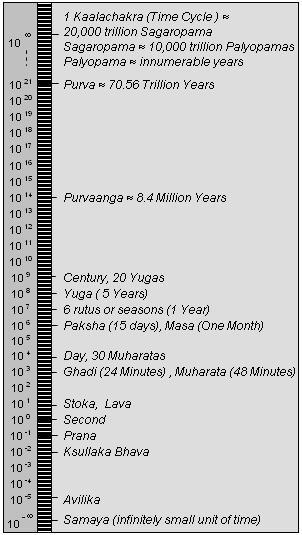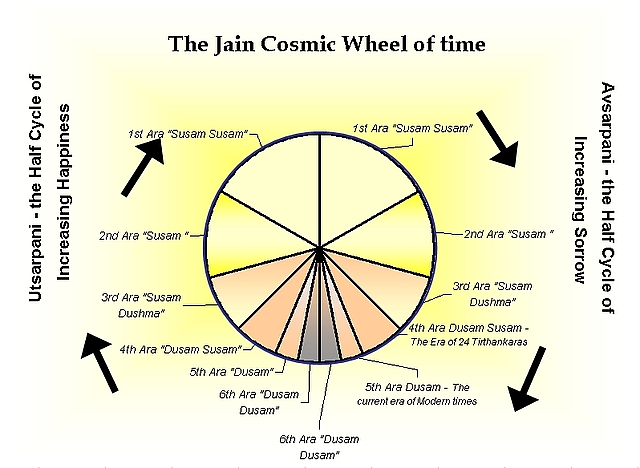Jain Time Cycle
According to Jainism, time is beginningless and eternal. The Kālacakra, the cosmic wheel of time, rotates ceaselessly. The wheel of time is divided into two half-rotations, Utsarpiṇī or ascending time cycle and Avasarpiṇī, the descending time cycle, occurring continuously after each other. Utsarpiṇī is a period of progressive prosperity and happiness where the time spans and ages are at an increasing scale, while Avsarpiṇī is a period of increasing sorrow and immorality with decline in timespans of the epochs. Each of this half time cycle consisting of innumerable period of time (measured in Sagaropama and Palyopama years) is further sub-divided into six aras or epochs of unequal periods. Currently, the time cycle is in avasarpiṇī or descending phase with the following epochs.
| Name of the Ara | Degree of happiness | Duration of Ara | Average Height of People | Average Lifespan of People |
| Suṣama-suṣamā | Utmost happiness and no sorrow | 400 trillion sāgaropamas | Six Miles Tall | Three Palyopama Years |
| Suṣamā | Moderate happiness and no sorrow | 300 trillion sāgaropamas | Four Miles Tall | Two Palyopama Years |
| Suṣama-duḥṣamā | Happiness with little sorrow | 200 trillion sāgaropamas | Two Miles Tall | One Palyopama Years |
| Duḥṣama-suṣamā | Sorrow with little happiness | 100 trillion sāgaropamas | 1500 Meters | 705.6 Quintillion Years |
| Duḥṣamā | Sorrow | 21,000 Years | 6 Feet | 130 Years Maximum |
| Duḥṣama- duḥṣamā | Extreme sorrow and misery | 21,000 Years | 1 Hatha | 16-20 Years |
 Suṣama-suṣamā - During the first ara of the Avsarpini, people lived for three palyopama years. During this ara people were on average six miles tall. They took their food on every fourth day; they were very tall and devoid of anger, pride, deceit, greed and other sinful acts. Various kinds of the kalpa trees fulfilled their wishes and needs like food, clothing, homes, entertainment, jewels etc.
Suṣama-suṣamā - During the first ara of the Avsarpini, people lived for three palyopama years. During this ara people were on average six miles tall. They took their food on every fourth day; they were very tall and devoid of anger, pride, deceit, greed and other sinful acts. Various kinds of the kalpa trees fulfilled their wishes and needs like food, clothing, homes, entertainment, jewels etc.
- Suṣamā - During the second ara the people lived for two palyopama years. During this ara people were on average 4 miles tall. They took their food at an interval of three days, but the kalpa trees supplied their wants, less than before. The land and water became less sweet and fruitful than they were during the first ara.
- Suṣama-duḥṣamā - During the third ara, the age limit of the people became one palyopama year. During this are people were on average 2 miles tall. They took their food on every second day. The earth and water as well as height and strength of the body went on decreasing and they became less than they were during the second ara. The first three ara the children were born as twins, one male and one female, who married each other and once again gave birth to twins. On account of happiness and pleasures, the religion, renunciation and austerities was not possible. At the end of the third ara, the wish-fulfilling trees stopped giving the desired fruits and the people started living in the societies. The first Tirthankara, Ṛṣabhdeva was born at the end of this ara. He taught the people the skills of farming, commerce, defence, politics and arts(intotal 72 arts for men and 64 arts for women) and organised the people in societies. That is why he is known as the father of human civilisation.
- Duḥṣama-suṣamā - During the fourth ara, people lived for 705.6 Quintillion Years. During this are people were on average 1500 Meters tall. The fourth ara was the age of religion, where the renunciation, austerities and liberation was possible. The 63 Śalākāpuruṣas, or the illustrious persons who promote the Jain religion, regularly appear in this ara. The balance 23 Tīrthaṅkars, including Lord Māhavīra appeared in this ara. This ara came to an end 3 years and 8 months after the nirvāṇa of Māhavīra.
- Duḥṣama - According to Jain cosmology, currently we are in the 5th ara. As of 2011, exactly 2,535 years have elapsed and 18,465 years are still left. It is an age of sorrow and misery. The maximum age a person can live to in this ara is 130 years. The maximum height a person can be in this ara is six feet. No liberation is possible, although people practice religion in lax and diluted form. At the end of this ara, even the Jain religion will disappear, only to appear again with the advent of 1st Tirthankara in the next cycle.
- Duḥṣama - duḥṣama - The sixth ara will be the age of intense misery and sorrow, making it impossible to practice religion in any form. The age, height and strength of the human beings will decrease to a great extent. In this ara people will live for no more than 16–20 years. This trend will start reversing at the onset of utsarpiṇī kāl.
In utsarpiṇī the order of the aras is reversed. Starting from Duḥṣama- duḥṣamā, it ends with Suṣama-suṣamā and thus this never ending cycle continues. Each of these aras progress into the next phase seamlessly without any apocalyptic consequences. The increase or decrease in the happiness, life spans and length of people and general moral conduct of the society changes in a phased and graded manner as the time passes. No divine or supernatural beings are credited or responsible with these spontaneous temporal changes, either in a creative or overseeing role, rather human beings and creatures are born under the impulse of their own karmas.
